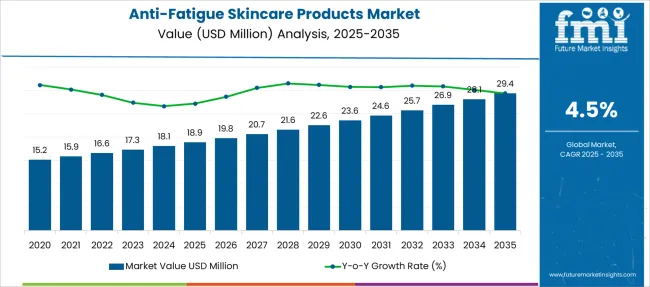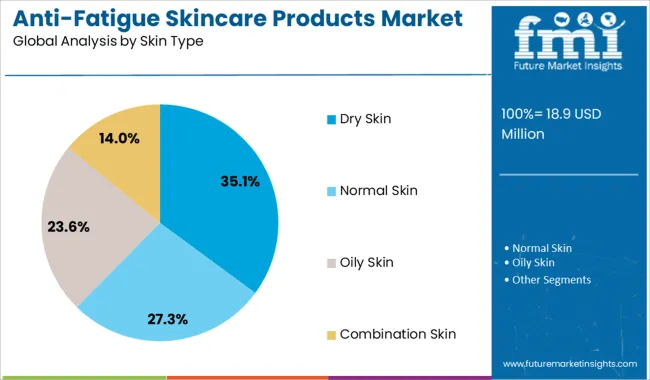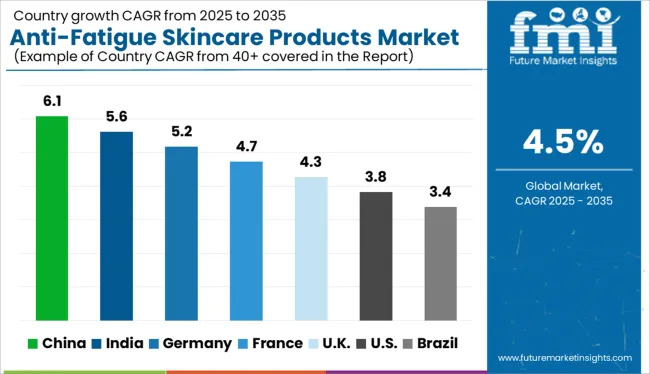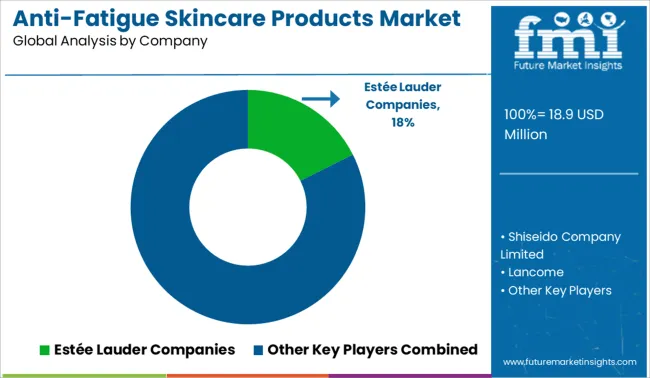The Anti-Fatigue Skincare Products Market is estimated to be valued at USD 18.9 million in 2025 and is projected to reach USD 29.4 million by 2035, registering a compound annual growth rate (CAGR) of 4.5% over the forecast period.

| Metric | Value |
|---|---|
| Anti-Fatigue Skincare Products Market Estimated Value in (2025 E) | USD 18.9 million |
| Anti-Fatigue Skincare Products Market Forecast Value in (2035 F) | USD 29.4 million |
| Forecast CAGR (2025 to 2035) | 4.5% |
The anti-fatigue skincare products market is gaining traction globally due to rising consumer awareness of skin health, stress-induced aging, and the growing demand for multifunctional cosmetic solutions. Increased urbanization, digital exposure, and erratic sleep patterns have contributed to premature skin fatigue, encouraging the adoption of targeted skincare routines.
Formulations enriched with antioxidants, caffeine, peptides, and vitamin complexes are seeing accelerated use in both mass and premium categories. Brands are focusing on clinical efficacy, dermatological validation, and minimalist ingredient lists to meet evolving consumer expectations.
In parallel, the influence of wellness trends and self-care culture, combined with increasing disposable income among middle-class demographics, is reshaping purchase behavior. As e-commerce expands reach and personalization technologies become embedded in online platforms, the market is expected to witness innovation in delivery systems, textures, and on-the-go formats for fatigue-targeting skincare.
The market is segmented by Product Type, Consumer Orientation, Skin Type, Nature of Product, and Distribution Channel and region. By Product Type, the market is divided into Creams, Oils, Lotions, and Others. In terms of Consumer Orientation, the market is classified into Women, Men, and Unisex. Based on Skin Type, the market is segmented into Dry Skin, Normal Skin, Oily Skin, and Combination Skin. By Nature of Product, the market is divided into Organic and Conventional. By Distribution Channel, the market is segmented into Online Store, Hypermarket/Supermarket, Specialty Stores, Pharmacies, Independent Stores, and Direct Sales. Regionally, the market is classified into North America, Latin America, Western Europe, Eastern Europe, Balkan & Baltic Countries, Russia & Belarus, Central Asia, East Asia, South Asia & Pacific, and the Middle East & Africa.

Creams are projected to account for 39.7% of total revenue in the anti-fatigue skincare products market in 2025, making them the leading product type. Their dominance stems from their versatility, deep moisturizing properties, and ease of formulation with active ingredients designed to revitalize tired skin.
Creams offer a stable medium for the inclusion of anti-oxidants, retinoids, and hydrating agents, making them highly effective for overnight repair and visible fatigue reduction. Consumers continue to associate creams with comfort and efficacy, particularly for intensive skin recovery in colder climates and nighttime routines.
The format’s adaptability across age groups and price ranges ranging from accessible drugstore options to high-end dermocosmetics has further expanded its adoption. As consumers seek visible and sensorial results without harsh ingredients, cream-based anti-fatigue formulations remain a cornerstone in skincare regimens.

Women are expected to contribute 52.4% of the anti-fatigue skincare products market revenue in 2025, maintaining their position as the dominant consumer group. This leadership is being driven by heightened awareness around early signs of aging, work-life stress, and the prioritization of self-care routines.
Women represent a more engaged skincare audience, often seeking targeted solutions for under-eye fatigue, dullness, and uneven texture concerns that align with anti-fatigue positioning. Strong marketing investments, influencer-led product education, and high engagement on beauty platforms have supported ongoing brand loyalty in this segment.
Product availability in a wide variety of textures, routines, and skincare systems tailored for women’s needs further contributes to its continued share dominance. As the segment matures, brands are also expanding into preventative care and lifestyle-based fatigue formulations to retain consumer interest.

Dry skin types are forecast to account for 35.1% of total market revenue by 2025, positioning them as the top segment by skin type. This dominance is attributed to increased sensitivity of dry skin to environmental stressors, which amplifies visible signs of fatigue such as fine lines, flakiness, and dull tone.
Anti-fatigue products tailored for dry skin typically focus on intensive hydration, barrier repair, and replenishment of essential lipids, making them highly desirable among consumers experiencing weather-induced or chronically dehydrated skin conditions. The compatibility of richer formulations with dry skin also facilitates the effective delivery of fatigue-reducing actives, boosting product performance.
As hydration continues to be a top concern across skincare categories, dry skin-targeted anti-fatigue solutions are projected to see consistent growth, especially in regions with colder or drier climates.
The busy lifestyle of the working population is the main reason for skin fatigue. Lack of sleep, smoking, inactivity, a poor diet, exposure to pollution and the sun, and ongoing stress are a few of the issues behind the market expansion for skincare products designed to combat poor skin health.
By utilizing topical creams with the right ingredients, these indicators of skin fatigue can be eliminated. The market for anti-fatigue skincare products has grown dramatically as a result of rising internet usage, rising disposable income, and companies' clever marketing. Many manufacturers have marketed their products as an effective solution for pollution damage, and featured influencers and actors in advertisements, gaining more popularity among customers.
Manufacturers are spending more money on research and development to create new goods with greater efficacy. The consumer demand for multi-featured anti-fatigue goods is anticipated to be significant. Additionally, the market for anti-fatigue skincare products with organic sources from nature is predicted to prosper with high potential.
The anti-fatigue skincare market faces many problems that are restraining market growth. The main challenge is the fluctuations in raw material prices. Manufacturers are starting to use natural ingredients in the production of anti-fatigue skincare products.
Almonds, aloe vera, kelp, rosemary, and other many plant extracts and essential oils are used in these products. As the raw material prices fluctuate, the manufacturers also have to adjust the production and final prices of the products. Customers may become uninterested due to these changes.
Irregularity in the use of these products is another restraint. Customers purchase products and use them a few times. Skincare products require regular use to get the best effect and healthy skin. Due to busy schedules, people forget about using these cosmetics and later on discard them as they did not have a positive effect on their skin health.

The USA is anticipated to be the biggest market for anti-fatigue skincare products. American people are aware about their health and well-being. Additionally, the hectic life of workers is another driving factor for skin care products.
Increasing pollution, poor diet, and lack of sleep are the main reasons for skin fatigue in Americans and customers are looking for effective skincare products.
Chinese households are using anti-fatigue skincare products. China is known for its fast-paced and busy life. Due to such hectic schedules, people from the country are under stress and are not getting enough sleep.
All of these causes, together with rising pollution, are making people's dark circles and skin pores bigger. People are beginning to utilize various anti-fatigue skincare products in order to lessen these symptoms and improve skin health.

Some key players in the Anti-Fatigue Skincare Products market are Shiseido Company Ltd., Lancome, L'Oréal, REN Clean Skincare, S.A. Thalgo T.C.H., Christian Dior SE, Estée Lauder Companies, Revlon, The Ales Group, Patentes Talgo S.L.U., Bio Veda Action Research Co., Groupe Clarins SA, and others.
| Attribute | Details |
|---|---|
| Growth Rate | CAGR of 4.5% from 2025 to 2035 |
| The base year for estimation | 2024 |
| Historical Data Available for | 2020 to 2024 |
| Forecast Period | 2025 to 2035 |
| Quantitative units | Revenue in USD Million, volume in Units, and CAGR from 2025 to 2035 |
| Report Coverage | Revenue forecast, volume forecast, company ranking, competitive landscape, growth factors, and trends, pricing analysis |
| Segments Covered | Product Type, Consumer Orientation, Skin Type, Nature of Product, Distribution Channel, Region |
| Country scope | USA, Canada, Mexico, Germany, United Kingdom, France, Italy, Spain, Russia, India, Thailand, China, India, Japan, Australia, Brazil, Argentina, Colombia, Saudi Arabia, United Arab Emirates, South Africa |
| Key Companies Profiled | Shiseido Company Limited; Lancome; L'Oréal; REN Clean Skincare; S.A. Thalgo T.C.H.; Christian Dior SE; Estée Lauder Companies; Revlon; The Ales Group; Patentes Talgo S.L.U.; Bio Veda Action Research Co.; Groupe Clarins SA; Others |
| Customization scope | Free report customization (equivalent to up to 8 analysts' working days) with purchase. Addition or alteration to country, regional & segment scope. |
| Pricing and purchase options | Avail customized purchase options to meet your exact research needs. |
The global anti-fatigue skincare products market is estimated to be valued at USD 18.9 million in 2025.
The market size for the anti-fatigue skincare products market is projected to reach USD 29.4 million by 2035.
The anti-fatigue skincare products market is expected to grow at a 4.5% CAGR between 2025 and 2035.
The key product types in anti-fatigue skincare products market are creams, oils, lotions and others.
In terms of consumer orientation, women segment to command 52.4% share in the anti-fatigue skincare products market in 2025.






Full Research Suite comprises of:
Market outlook & trends analysis
Interviews & case studies
Strategic recommendations
Vendor profiles & capabilities analysis
5-year forecasts
8 regions and 60+ country-level data splits
Market segment data splits
12 months of continuous data updates
DELIVERED AS:
PDF EXCEL ONLINE
Skincare Supplement Market Size and Share Forecast Outlook 2025 to 2035
Skincare Oil Market Size and Share Forecast Outlook 2025 to 2035
Skincare Nutritional Serum Market Size and Share Forecast Outlook 2025 to 2035
Skincare Market Analysis - Size, Share, and Forecast Outlook 2025 to 2035
Skincare Packaging Market Size, Share & Forecast 2025 to 2035
Skincare Industry in India – Trends & Growth Forecast 2024-2034
Global Skincare Treatment Market Analysis – Size, Share & Forecast 2024-2034
Skincare Products Market Size and Share Forecast Outlook 2025 to 2035
Global PDRN Skincare Market Size and Share Forecast Outlook 2025 to 2035
Global Smart Skincare Market Size and Share Forecast Outlook 2025 to 2035
Men’s Skincare Products Market Size, Growth, and Forecast for 2025 to 2035
Cooling Skincare Gels Market Size and Share Forecast Outlook 2025 to 2035
Natural Skincare Preservatives Market Analysis - Size and Share Forecast Outlook 2025 to 2035
Ormedic Skincare Market Demand & Insights 2024-2034
Ceramide Skincare Market Size and Share Forecast Outlook 2025 to 2035
BPA-Free Skincare Market Trends – Demand & Forecast 2024-2034
Camellia Skincare & Cosmetics Market
Menopause Skincare Solutions Market Size and Share Forecast Outlook 2025 to 2035
Probiotic Skincare Ingredients Market Size and Share Forecast Outlook 2025 to 2035
Probiotic Skincare Solutions Market Size and Share Forecast Outlook 2025 to 2035

Thank you!
You will receive an email from our Business Development Manager. Please be sure to check your SPAM/JUNK folder too.
Chat With
MaRIA